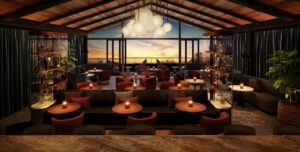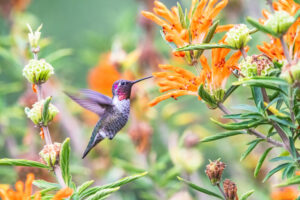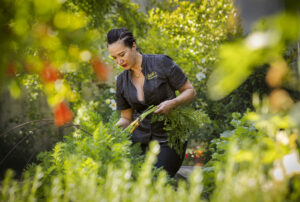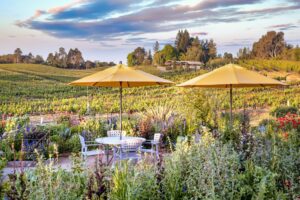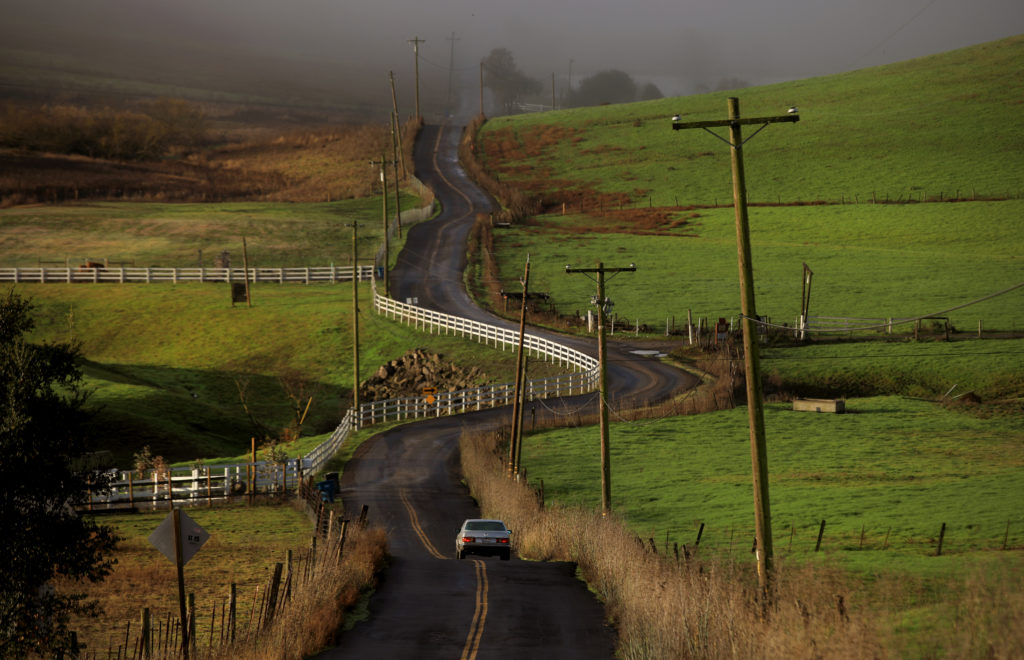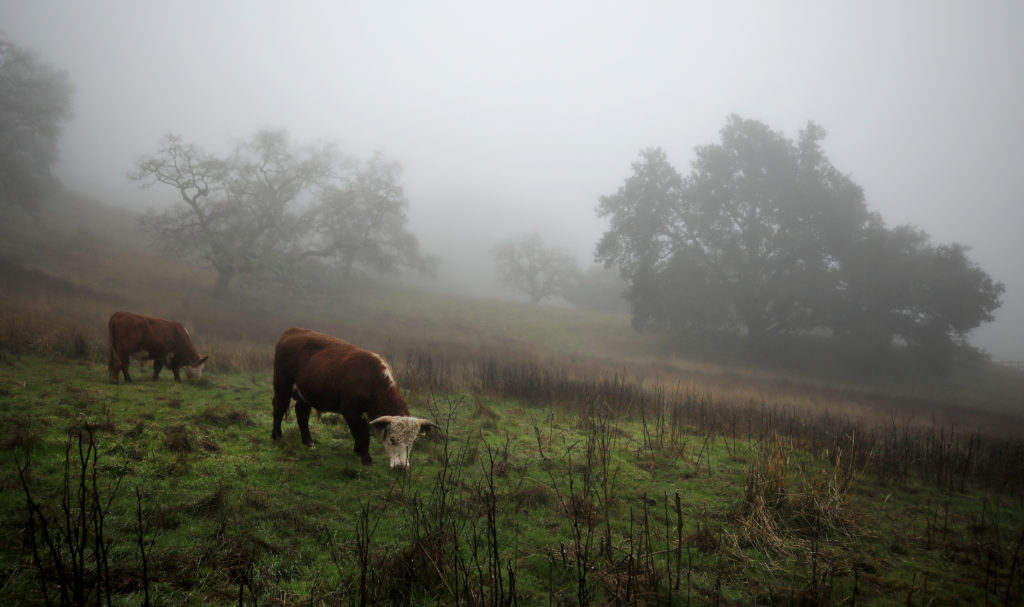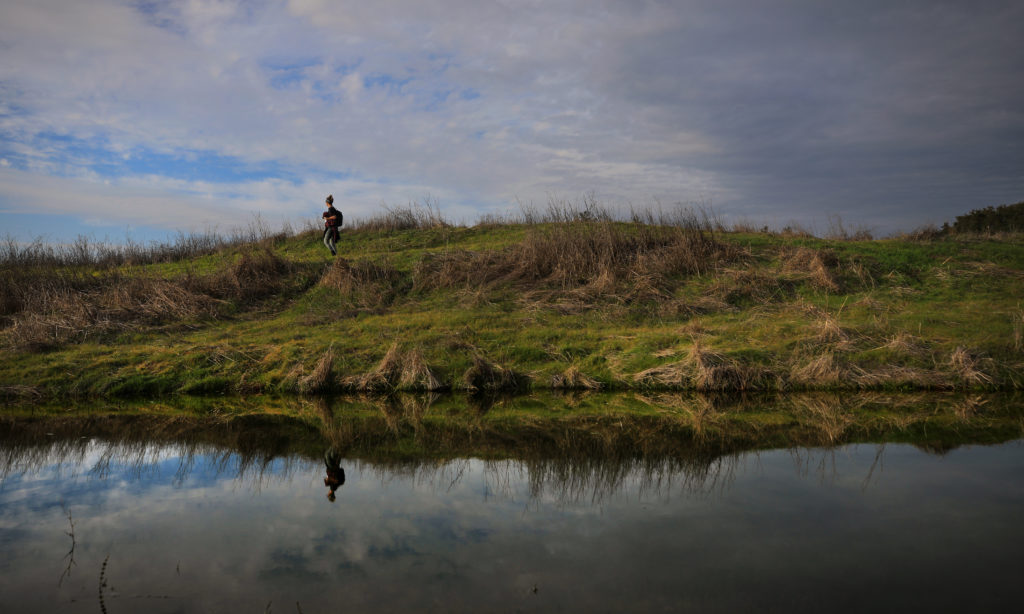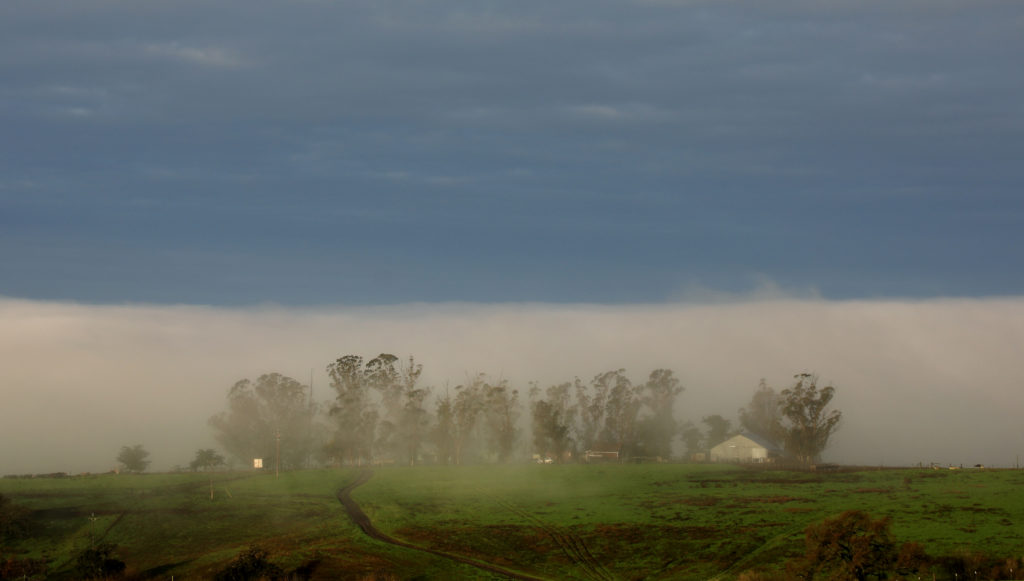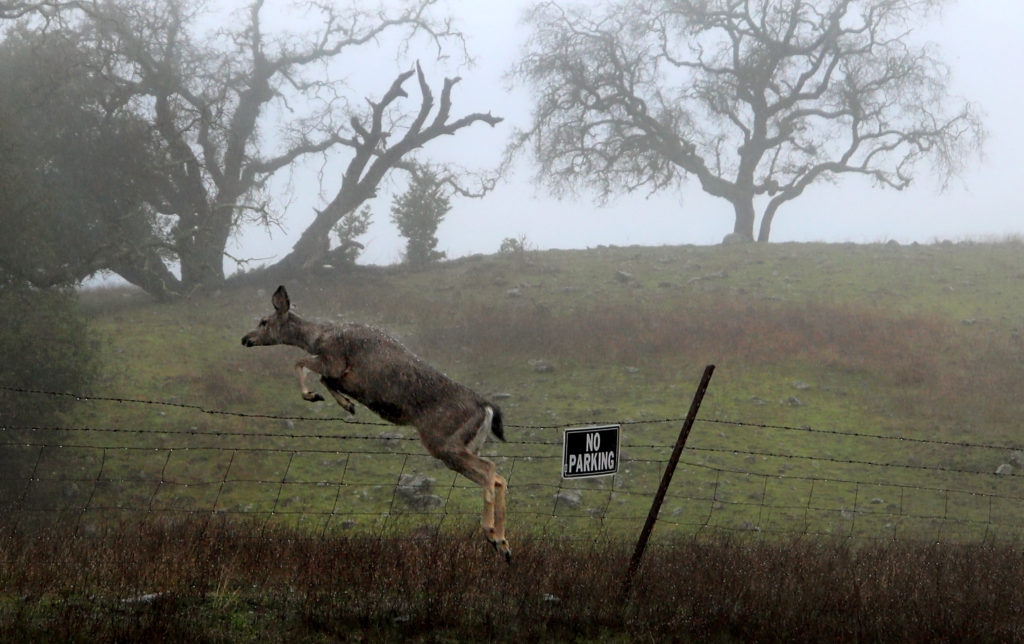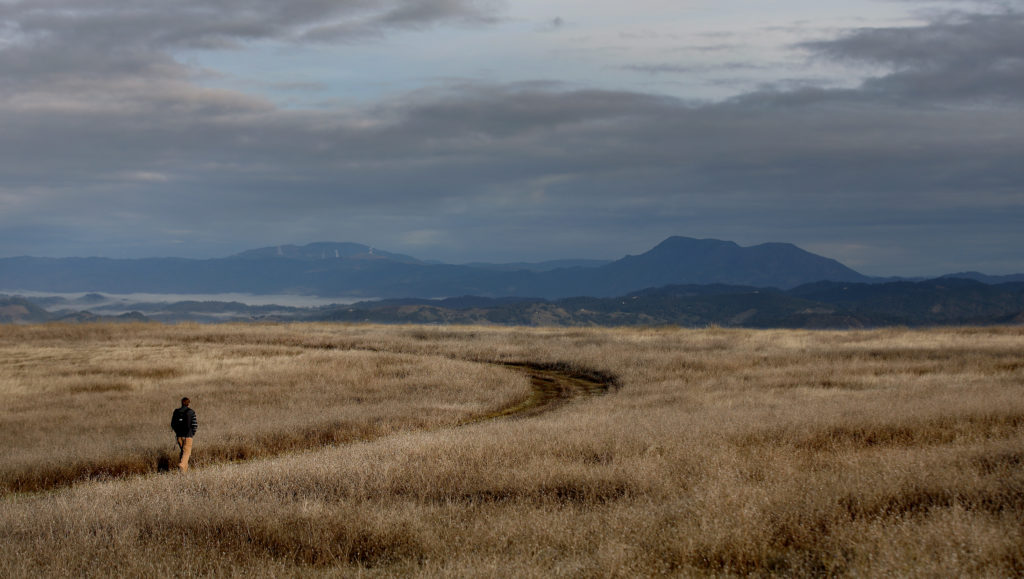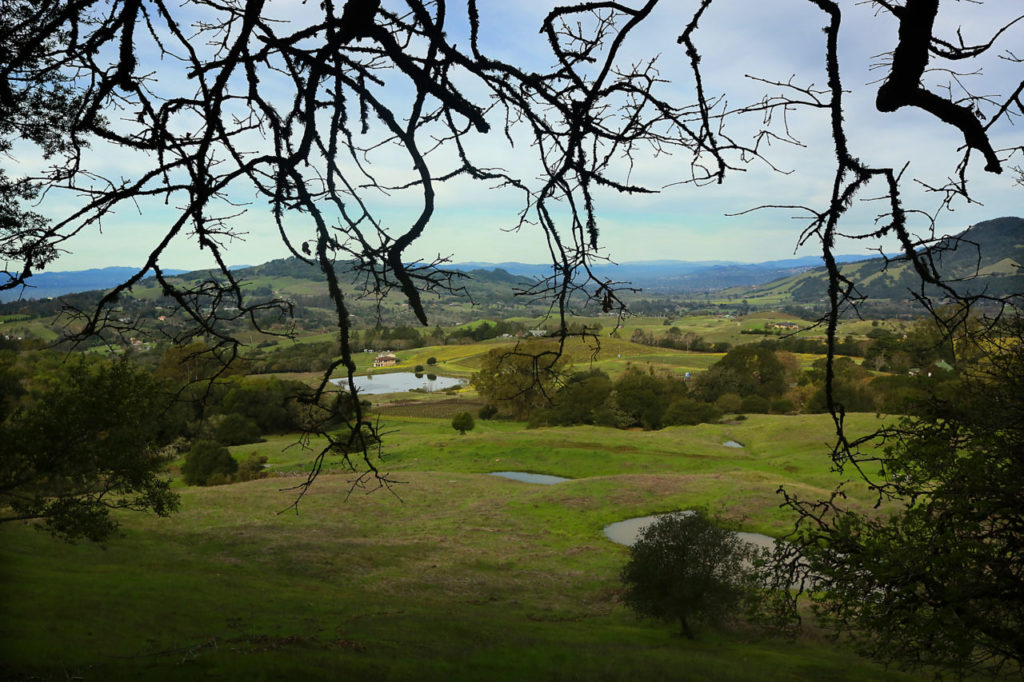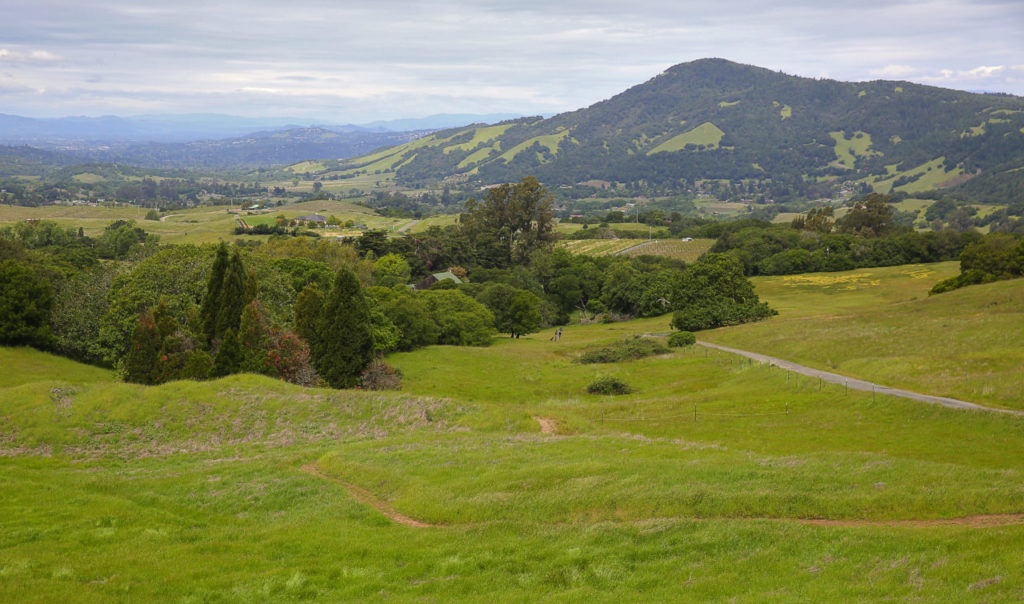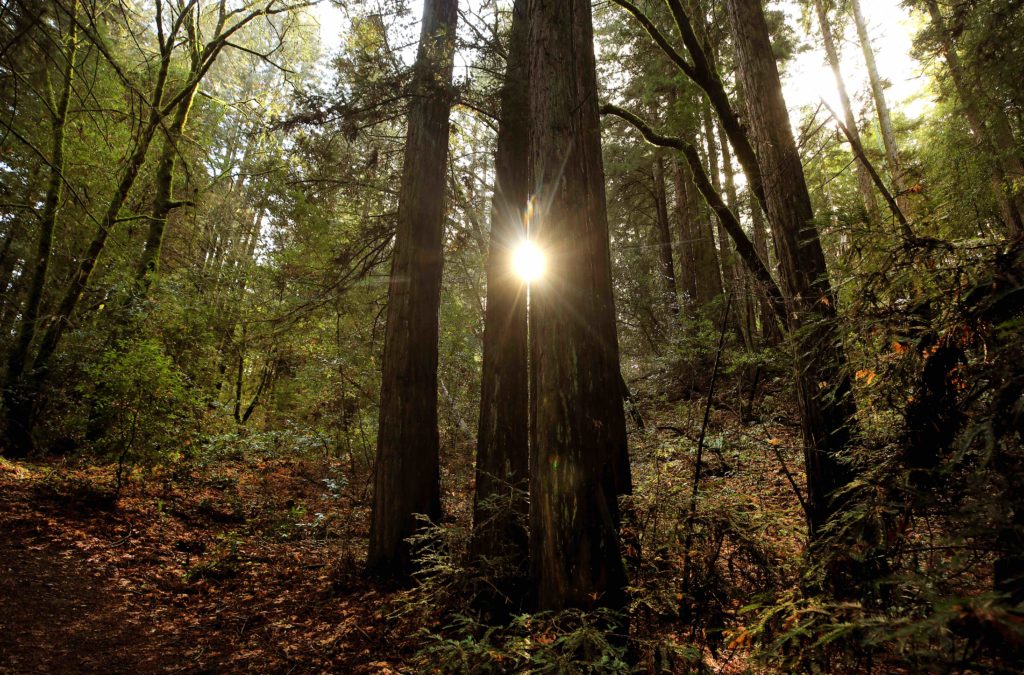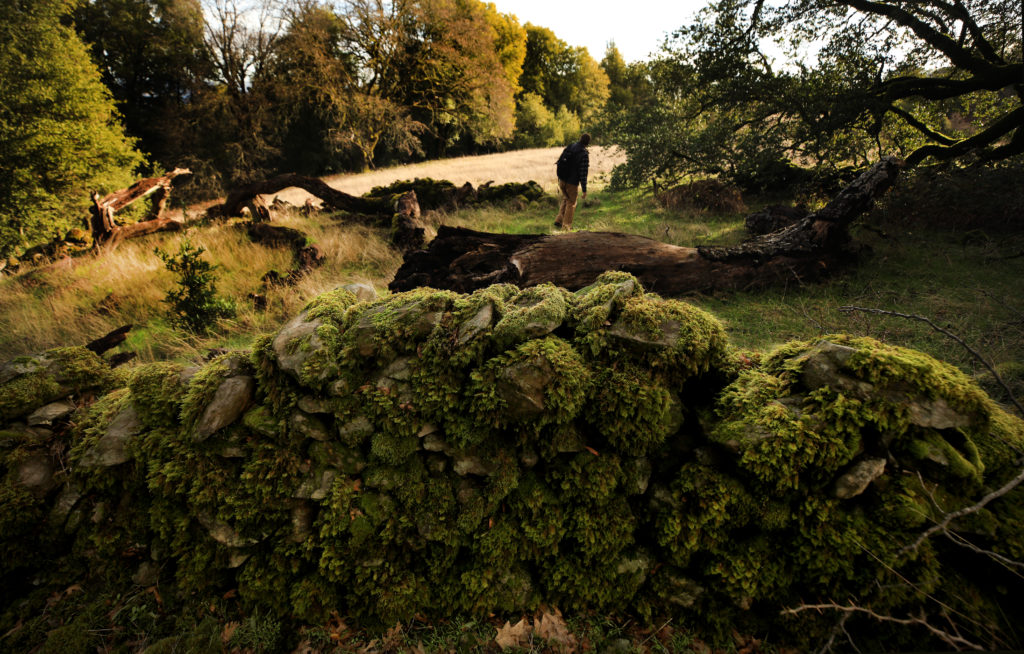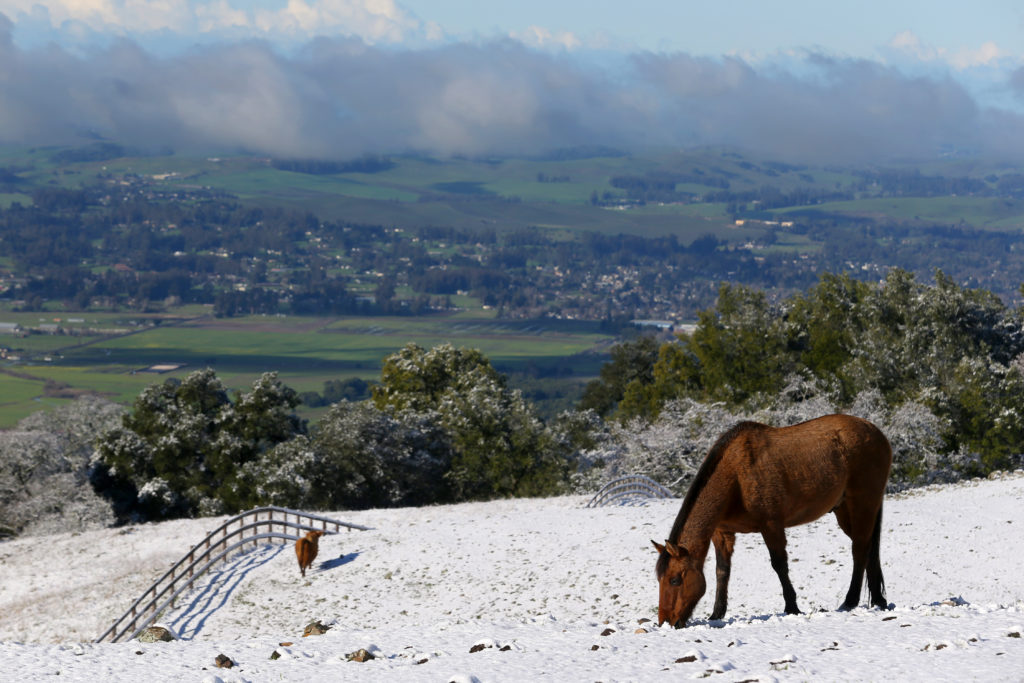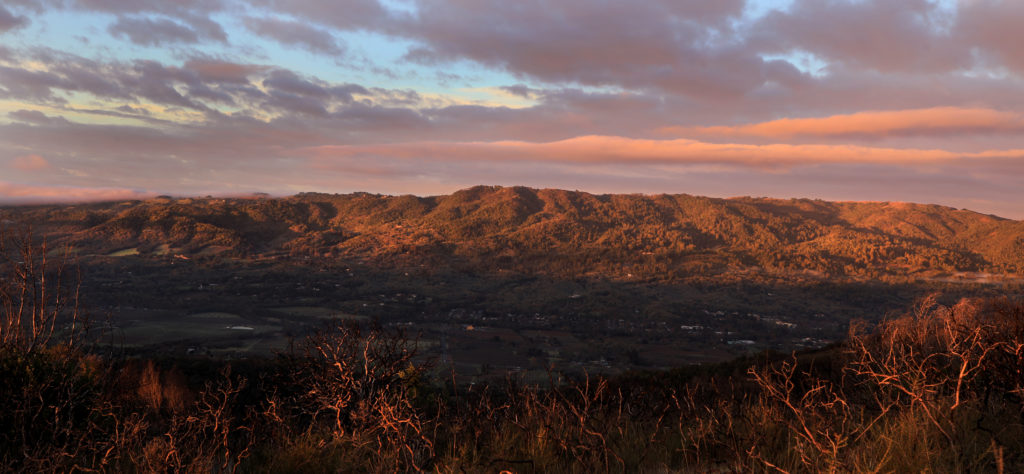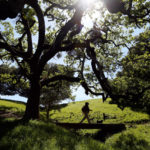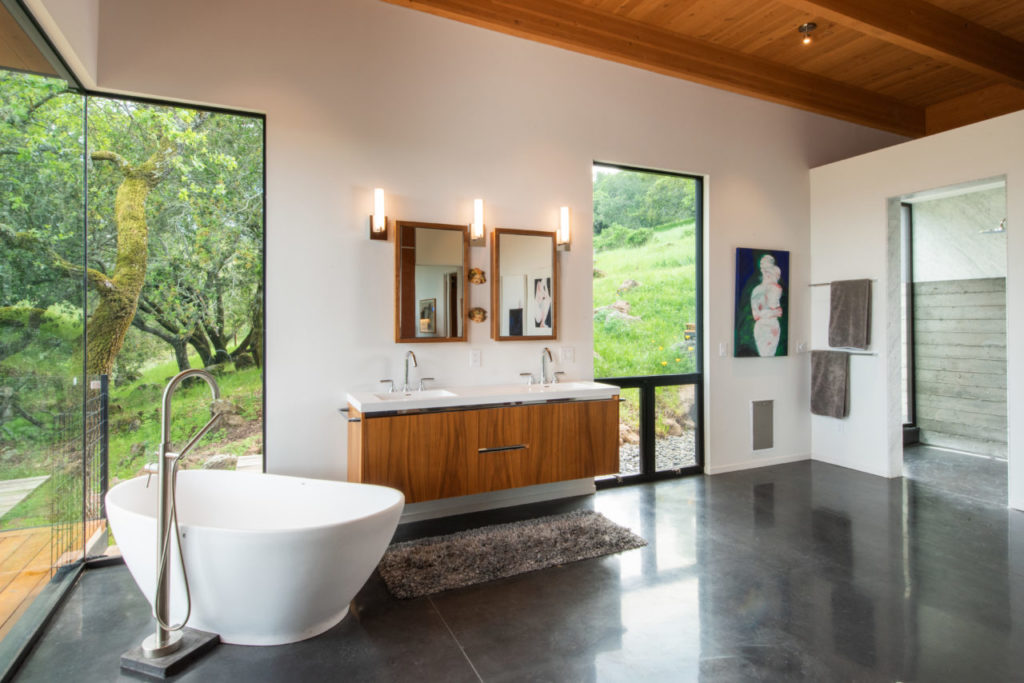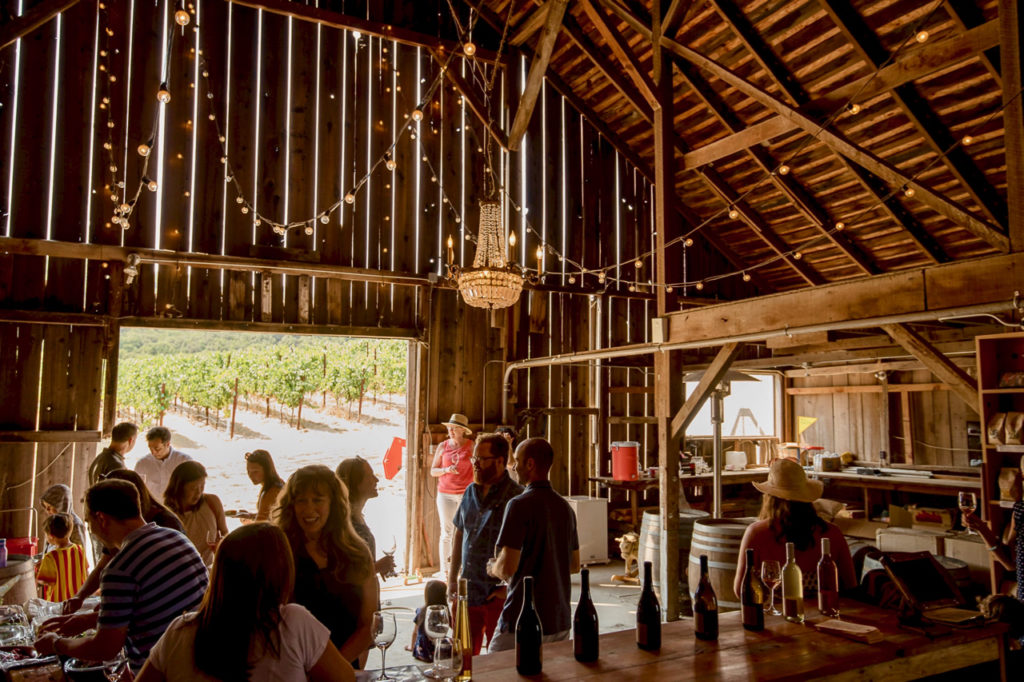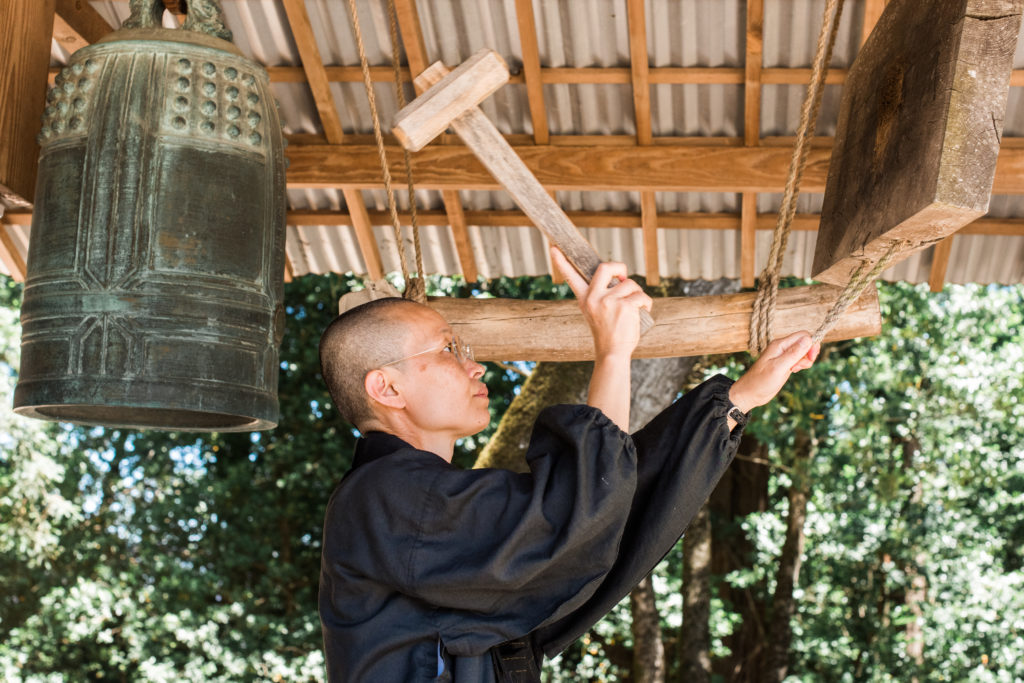Every day on the mountain was different, but each started out in the same way. First, in the utter blackness of pre-dawn, I’d be roused from sleep by the distant strikings of the gong at the Zen center a mile or so up the road summoning acolytes to zazen, the Buddhist practice of meditative sitting. I’d drift back into semi-slumber and vivid dreams, to be reawakened a short time later by the faint but exuberant crowing of scores of fighting cocks, the wards of a grape grower living across the way. Depending on the season, songbirds would vocalize with the waxing day, or there’d be silence. Maybe the sun would burst suddenly through my windows, or the light would be indirect and opalescent from fog or rain. But the gongs and roosters were the same, constituting a dependable and reassuring anchor to my life.
I lived on Sonoma Mountain for 15 years, and it’s been longer than that since I left. But I can still recall how it felt –not just to live there, but to be a part of it, to be sheltered and virtually subsumed by the place.
The mountain is a terrestrial lodestar for Sonoma County, albeit one hiding in plain sight. It’s not a mountain, in the sense that Mount Shasta and Mount St. Helena are mountains. It doesn’t rise spectacularly from the landscape, forming a symmetrical cone. It’s more of a long and mounded ridge. Located east of Petaluma and immediately west of Highway 12, it’s the first thing you see approaching the Petaluma River bridge on Highway 101 from the south. It looks like the rumpled form of a great beast sprawled prone and sleeping under the earth, its flanks and back covered with groves of oaks and grasslands.
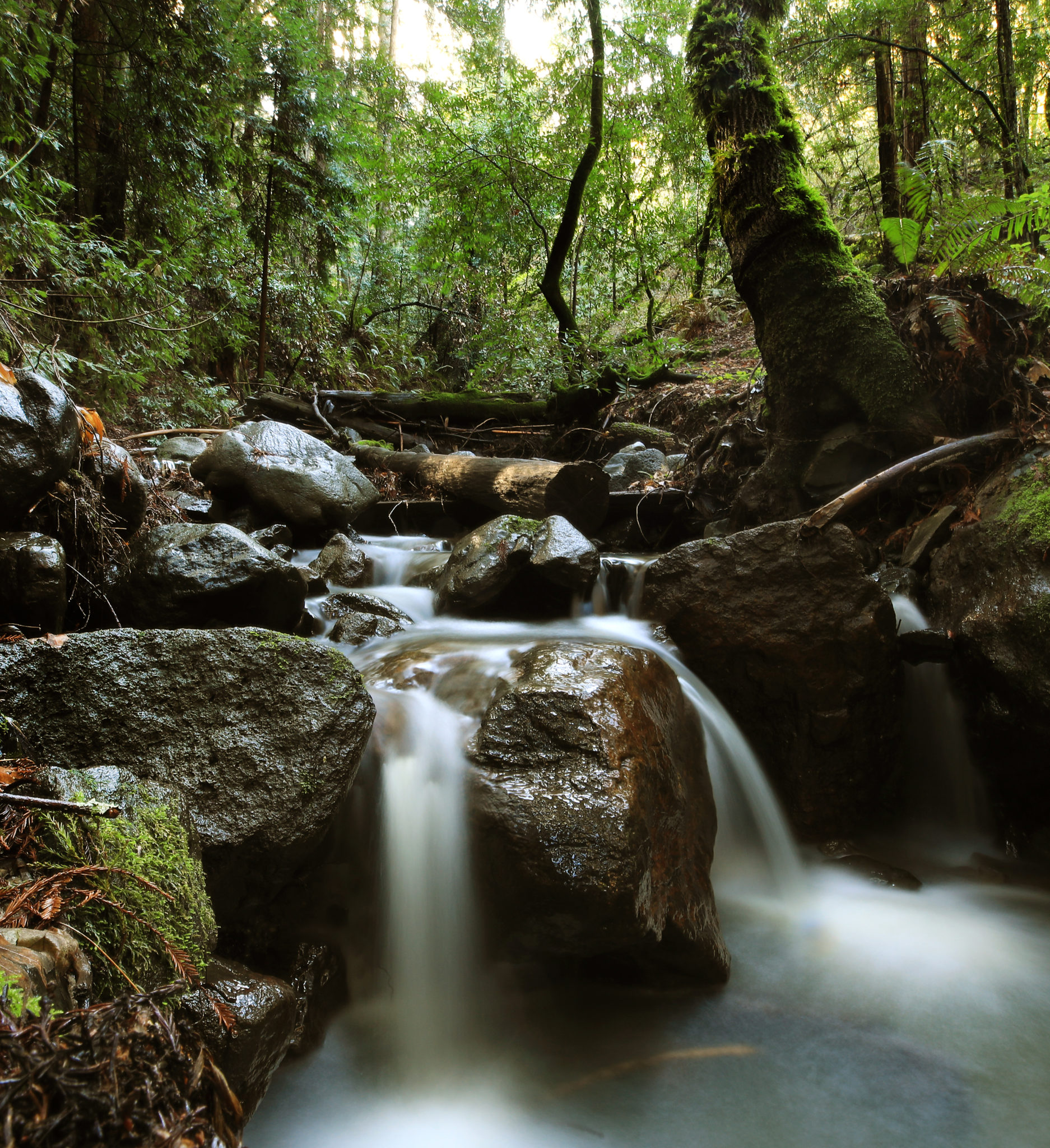
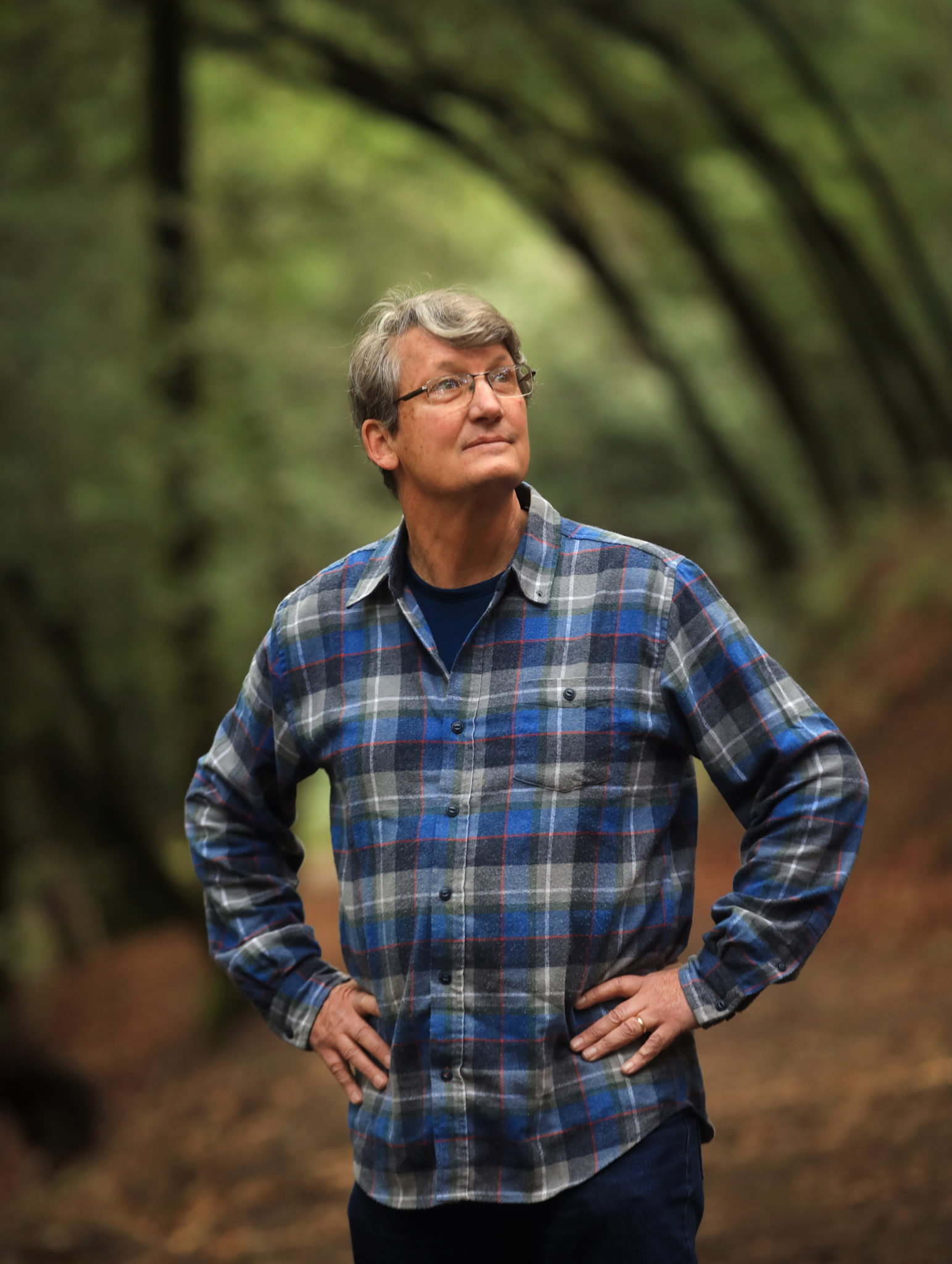
“It’s our mountain,” said Arthur Dawson, a Glen Ellen author who wrote the definitive book on the mountain. “There’s an intimacy about it. It’s not a peak. It’s a landscape, the headwaters for three watersheds. When you start familiarizing yourself with it, you realize how complex, how intricate it is.”
Sonoma Mountain has been a working landscape since the first people filtered into the Sonoma Valley region 12,000 years ago. They hunted game and harvested acorns and pinole – native grass seed – from its slopes.
The mountain was included in the land grant of Sonoma’s founder, Gen. Mariano Vallejo, and was used as a grazing commons. Jack London, one of the most prolific and famed authors of the early 20th century, inhabited a sprawling ranch on the mountain’s eastern slope — now one of the North Bay’s most popular state parks. The mountain has been logged repeatedly, fattened countless thousands of cattle on its meadows and seen vineyards come and go – and come again.
“Human habitancy, human history, is a big part of the story of Sonoma Mountain,” Dawson told me. “It always has been.”
And that deep-rooted history of settlement means that perspectives on the mountain change from one generation to the next. When I lived there, it was a place of private enclaves, of sheltered and isolated bowers.
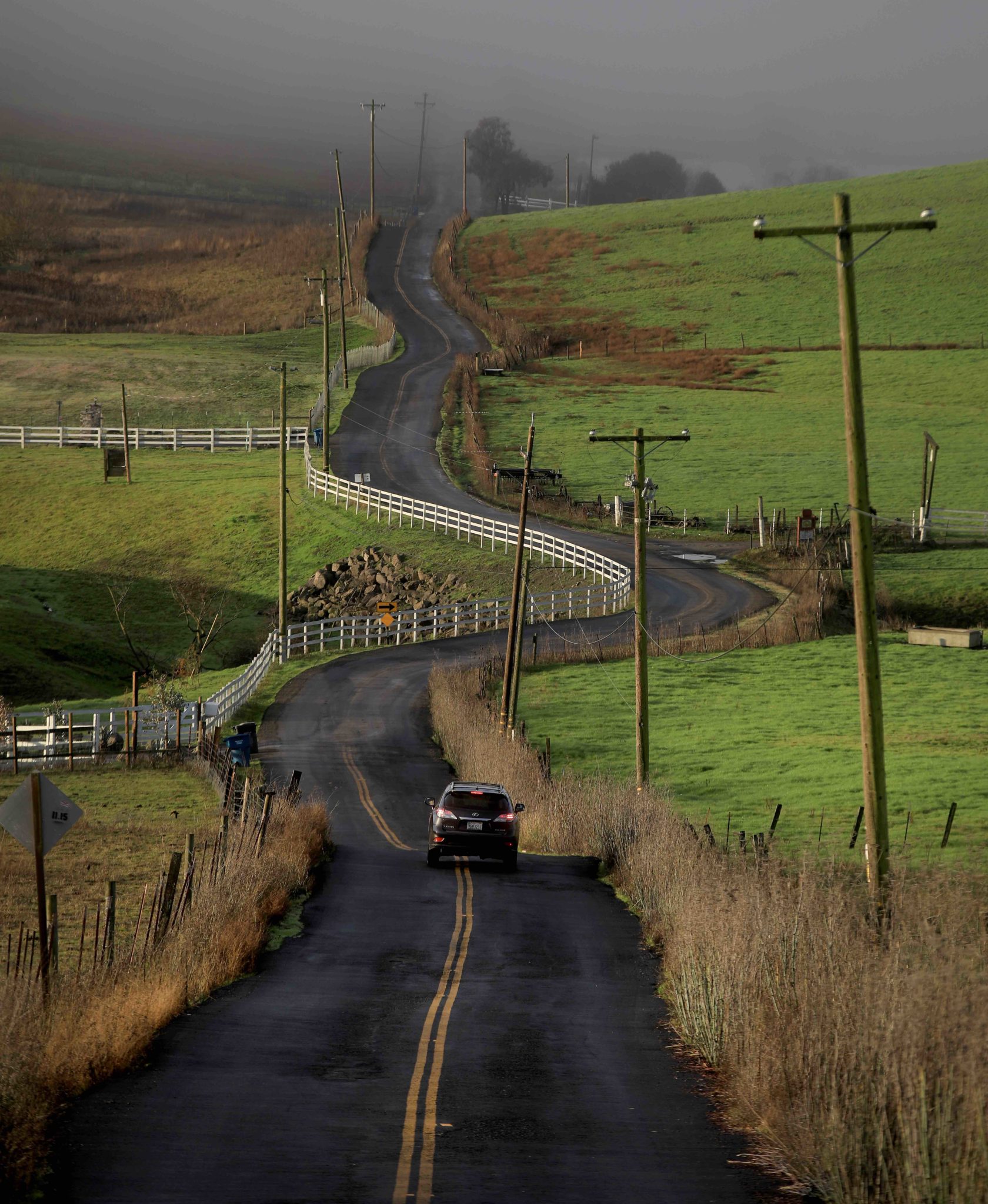
A 10-minute drive from downtown Santa Rosa would deliver you to a sylvan redoubt where civilization seemed distant, sometimes nonexistent. There are more vineyards now, more homes, a new public trail and park. A new winery and creamery promises to draw increasing numbers of visitors over Sonoma Mountain Road, the mountain’s main access route — a narrow and winding, and frankly, dangerous, strip of macadam.
I’ve wondered about these changes, wondered whether some tipping point between untrammeled nature and inexorable development had been reached, and how much of the green and bucolic mountain of my salad days remained. And so I set out, intent on exploring the evolving identity of a place unique in Sonoma County.
I began at North Sonoma Mountain Regional Park, an 820-acre public open space sandwiched between Rohnert Park and Glen Ellen. The regional park, opened in 2015, has afforded public access to a significant portion of the mountain, including a 4-mile trail that connects to Jack London State Historic Park, allowing visitors to experience the serenity and sense of well-being that residents have long treasured. When I lived there the mountain was wild and lush, a place with a great diversity of wildlife, from apex predators like mountain lions to rare and retiring amphibians. Bird populations were particularly robust and varied. Nearly all of it was cordoned off as private property, inaccessible to the public. The park atop the mountain changed that; but prior to setting out on the trail I was worried it wouldn’t be for the better.
I was heartened, however, when I drove to the park’s northern trailhead, located at the former property of the late Bill Jacobs. I knew Jacobs, a rancher who had extensive holdings across the mountain; I’d helped him put up hay.
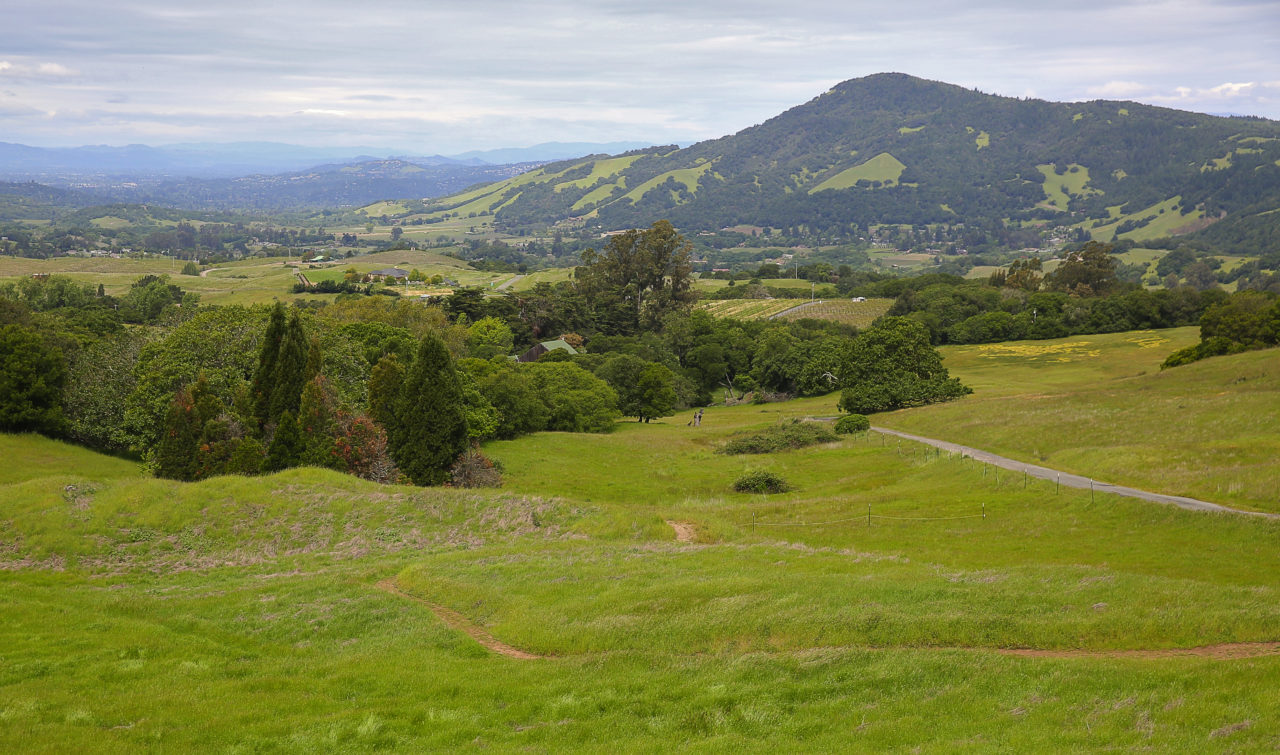
He was a huge man with hands the size of catcher’s mitts and a booming, stentorian voice that reminded me of the Warner Bros. cartoon rooster, Foghorn Leghorn. He’d occasionally slap me on the back when making a point, sending me sprawling. He was politically conservative, but the mountain was holy ground to him, as it was to most of us who lived there; he wanted to keep it open, green and agricultural. The sale of his 169-acre ranch in 2003 to the Sonoma County Agricultural Preservation and Open Space District kicked off the accumulation of parkland on the mountain, a $20 million taxpayer-funded effort that culminated in wide public access — a fitting tribute to the man, his vision, and his life’s work.
My hiking companions for the day were Dawson and Kim Batchelder, a natural resources planner with the open space district. The trail led us through a rich diversity of ecosystems: black oak groves and copses of enormous bay trees, bunchgrass meadows and stands of large redwoods. But this was not primeval territory. Breaks in the forest gave way to spectacular views of vineyards and pastures and the distant estates of Bennett Valley.
We passed through woods that had been repeatedly logged over many generations, and through clearings that have long been grazed. We crossed overgrown roads and abandoned fence lines, and there were far older traces of human occupancy available to a discerning eye. Some of the oak groves, Dawson said, show signs of cultivation — or husbandry, at least — from the Pomo who inhabited the mountain for millennia. Indigenous people periodically burned and cleared brush in oak groves and pruned the trees to maximize the acorn crop, the primary staple of their diet. I mentioned a large Pomo mortar, hewn from volcanic stone, that my landlord had discovered twisted in the roots of a giant bay tree near the mountain’s summit.
We hiked a bit farther, coming to a rough quadrangle of crumbling stone walls. “We know this was probably a livestock corral,” said Dawson, “and it probably dates from Vallejo’s time. It’s certainly earlier than the 1880s, when barbed wire came into general usage.” We sat down and contemplated the rock ruins, which remained strangely beautiful in their decay, as the wind soughed through the branches of a nearby bay tree.
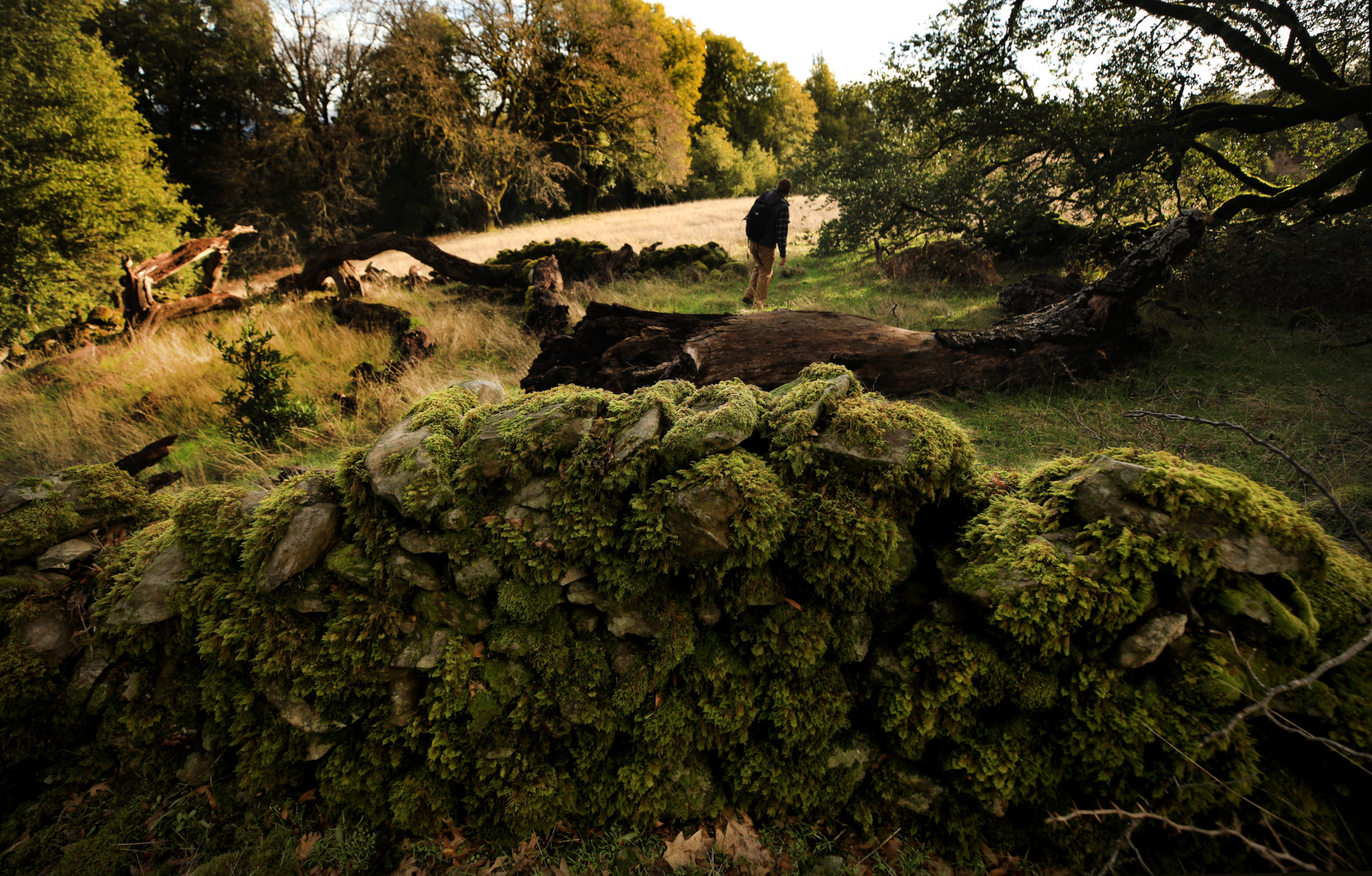
The mountain’s geographical prominence and natural abundance made it a regional cynosure for native people, says Greg Sarris, the chairman of the Federated Indians of Graton Rancheria and a professor of Native American Studies at Sonoma State University. Sarris lives on a 3-acre property on the west side of the mountain; the Rohnert Park casino owned by his tribe is visible below on the Santa Rosa Plain.
“There were so many nations in this area,” he said. “And that was the case for thousands and thousands of years. We [Pomo and coastal Miwok] were here when San Francisco Bay filled up after the last ice age. We watched that. And this mountain was a marker, a place shared by everyone. With so many nations, boundaries were very important. But Sonoma Mountain was an intersection for multiple boundaries, a magical place that all shared. I think the tremendous diversity of landscapes and the spectacular overviews helped confirm its sacredness to the people. They didn’t fight on it or for it, as they sometimes did down on the flatlands.”
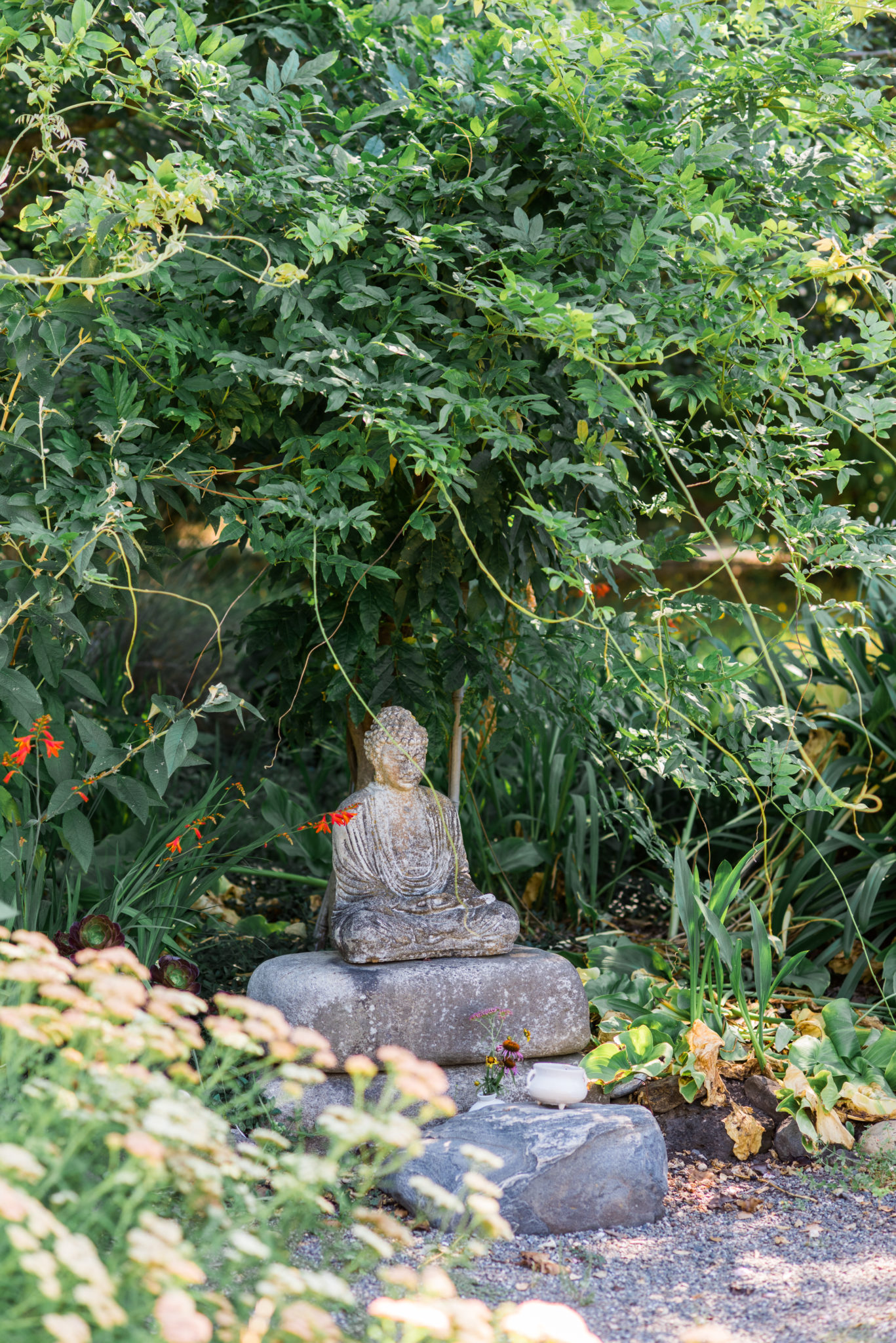
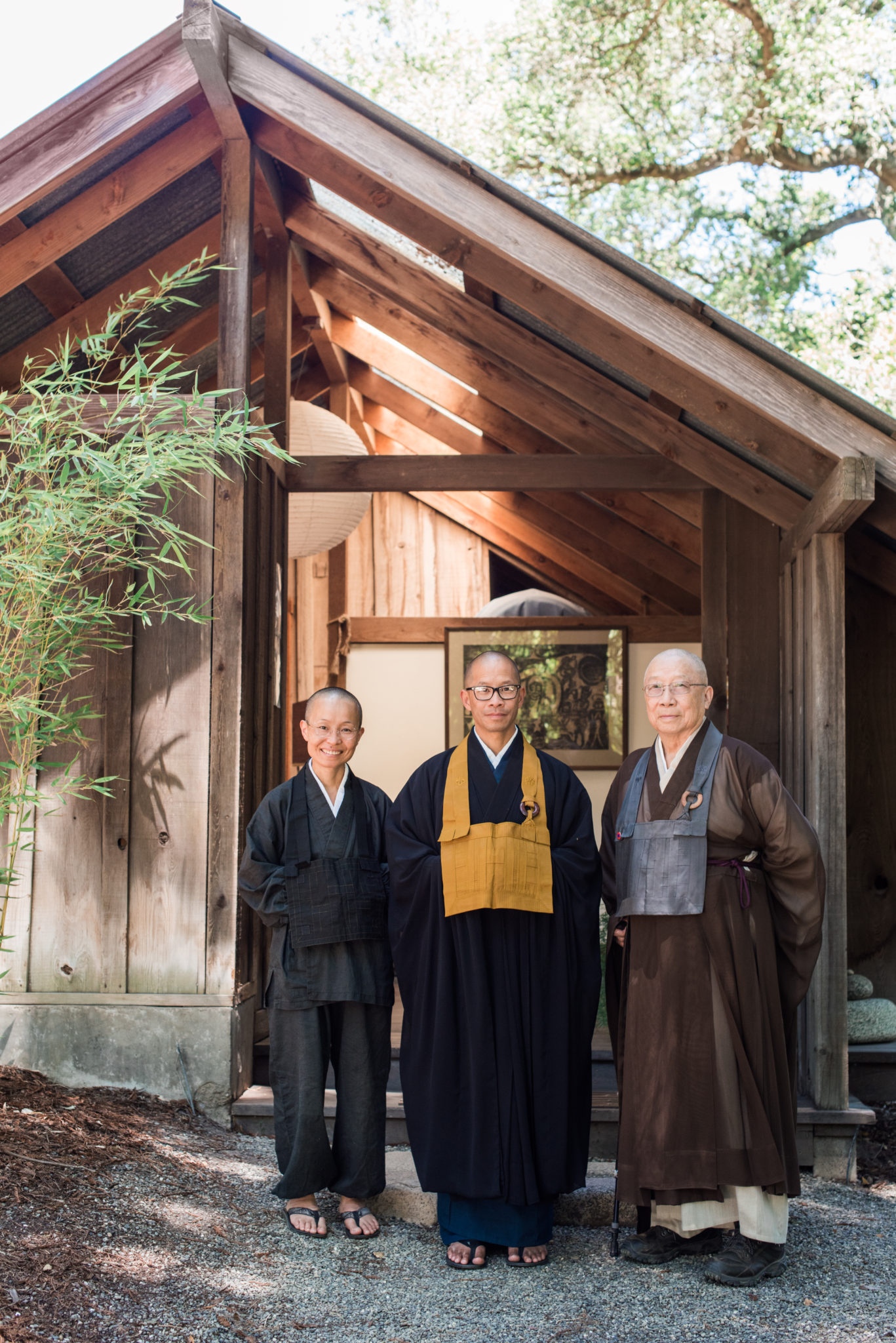
Sonoma Mountain has been a spiritual focal point for subsequent residents as well. The Sonoma Mountain Zen Center, founded on 80 acres of woodlands in 1973, draws Zen Buddhist acolytes from around the world, and its location is central to its mission. Nyoze Kwong Fukojushok, vice abbot of the Zen Center and son of founder Jakusho Kwong-roshi, grew up on the mountain and observed that his community’s primary spiritual practice — zazen, or meditative sitting — is sustained by the center’s locale.
“The mountain sits through and endures all conditions, rain, snow — it doesn’t matter,” said Kwong. “It doesn’t move. It remains still, grounded to the entire universe. That concept is central to zazen. We connect ourselves to the mountain — and the universe — when we sit.”
And few if any observations on the spiritual mana of the mountain have been more apt and widely repeated than a passage from Jack London’s “John Barleycorn.” It’s been used, appropriately enough, on the back labels of wines bearing the Jack London Ranch appellation:
“I ride over my beautiful ranch. Between my legs is a beautiful horse. The air is wine. The grapes on a score of rolling hills are red with autumn flame. Across Sonoma Mountain wisps of sea fog are stealing. The afternoon sun smolders in the drowsy sky. I have everything to make me glad I am alive. I am filled with dreams and mysteries.”
The mountain still holds that power, making you feel glad to be alive, exerting its force on current residents. Among them is David Best, an artist renowned for his construction of stunning edifices from found materials — including elaborate temples that anchor the annual Burning Man celebrations in Nevada. Best has lived on the west side of Sonoma Mountain for five decades, and when he first moved to his property, he felt more aligned with the local ranchers than the art community. “I can’t claim to be a gentleman farmer because I’m not a gentleman, but this land — it does have a hold on me.”
As Sonoma County’s population has swelled, environmental pressures on the mountain have grown in lockstep. I saw it when I lived there. Best has seen it in the increasing volume of trash strewn along the mountain’s roads, and he noted that a kind of “neighborhood watch” mentality has gripped some of his neighbors over trespassing, littering, and vandalism. He understands their concerns, he says — he devotes a significant amount of time to simply picking up trash along Sonoma Mountain Road — but he refuses to adopt a territorial view of the mountain.
“This is one of the last places around here that people can just drive up and see a beautiful view,” he said. “People need to see these places. We don’t own this land. We’re just taking care of it for a while.”
Best’s observation speaks to the perennial problem of balancing public access with land conservation. That dilemma wasn’t really relevant for Sonoma Mountain until relatively recently, when a vision for both preservation and public recreation came to fruition.
The vision was promoted by the late conservationists Ted and Pat Eliot. Ted, a career U.S. diplomat, and Pat, who had worked as a teen at Jack London Ranch resort, bought a 50-acre parcel on the mountain in the 1970s and became involved in efforts to preserve the mountain’s landscapes and expand public access, co-founding Sonoma Mountain Preservation in 1993. Soon after its formation, the group stopped an ambitious development project planned for the southern portion of Sonoma Mountain’s summit. It then arranged the transfer of 600 acres of the Sonoma Developmental Center to Jack London State Historic Park and drew up a set of development guidelines that ultimately was approved by the county.
The Eliots established a conservation and trail easement on their land, and spent their later years cajoling neighboring landowners to take similar steps, resulting in North Sonoma Regional Park, which now ends at a loop at the former Eliot property on the mountain’s east slope. The process was seldom if ever antagonistic, says their daughter Wendy Eliot, conservation director of the Sonoma Land Trust.
“It took 17 or 18 years, but they accomplished what they set out to do,” said Wendy Eliot. “Nature was essentially my father’s religion.”
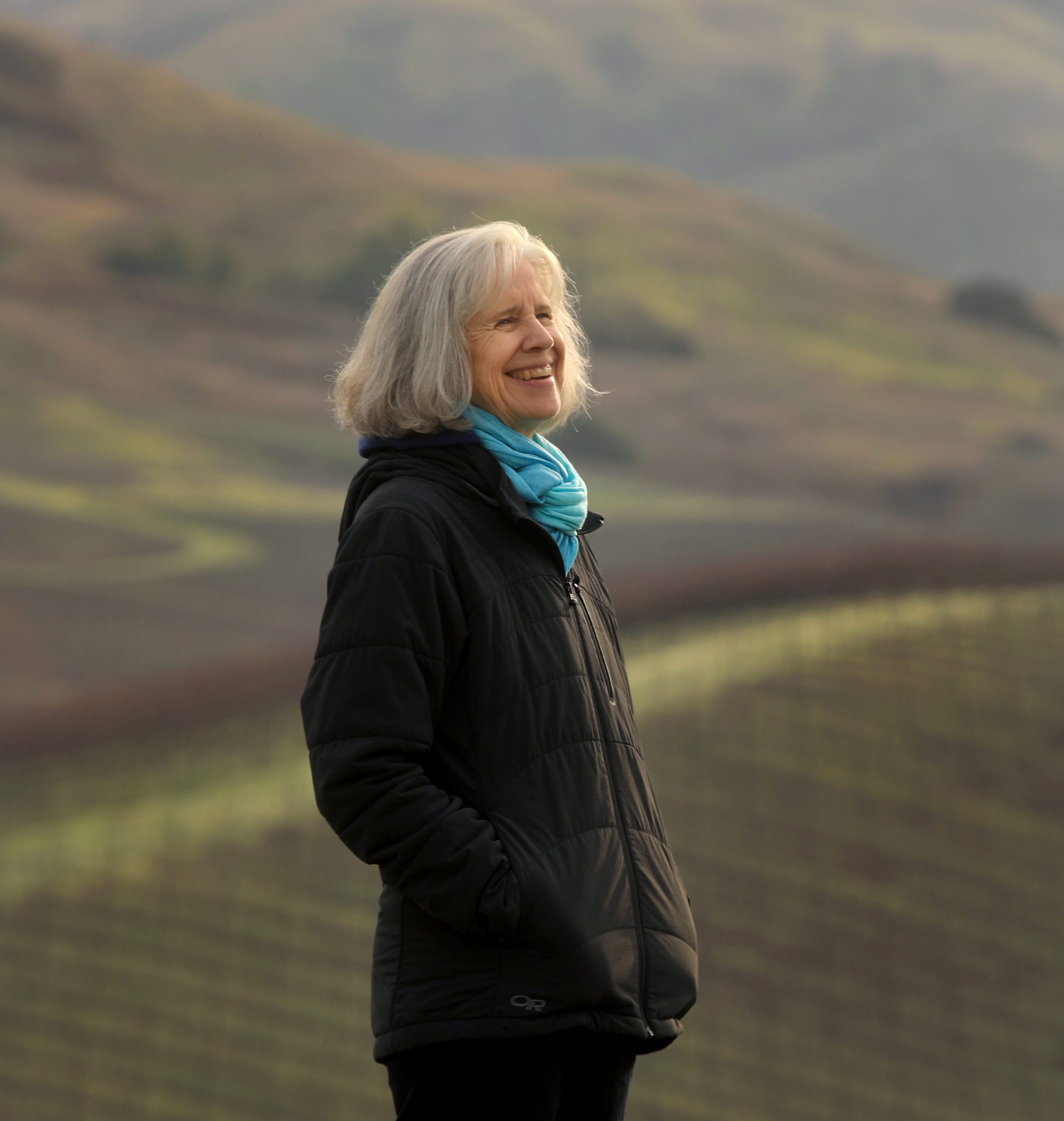
Sonoma Mountain has entered a new era with the establishment of the regional park. Residential subdivisions are no longer a threat, but the danger the mountain could literally be loved to death by visitors is real. So what’s the best way forward?
“It’s a matter of balance,” says Steve Ehret, project manager for Sonoma County Regional Parks and a lead figure in the design of the North Sonoma Mountain open space. Ehret’s charge is to implement the vision promoted by the Eliots and their allies — a vision that placed equal emphasis on public access and preservation. Sonoma Mountain needs a public constituency for effective preservation, Ehret says, and the new North Sonoma Mountain open space — along with a network of other public lands, including Jack London State Historic Park, Crane Creek Regional Park, and the Fairfield Osborn Preserve east of Rohnert Park — provide that.
“We have to manage the mountain so the resources aren’t degraded, and direct experience through public access is the best way to accomplish that,” Ehret said.
Mickey Cooke has a far longer perspective on the mountain’s evolution than most people alive today. She was close friends with Pat Eliot and worked with her to found Sonoma Montain Preservation. She knew Charmian London, Jack London’s widow, and was also pals with Milo Shepard, London’s grand-nephew. Now 88, she lives in a small but airy home tucked into the flank of the mountain near Glen Ellen.
For much of Cooke’s early life, the mountain was mainly divided among large ranches, and horses were a preferred means of transport. As a young woman, she’d often ride her horses along the mountain’s trails and ridgetop meadows from Glen Ellen to Petaluma and back. The memories of those rides and her beloved mounts remain vivid. “Sometimes I wake up and I can still hear them talking to me,” she said, “just like they’re outside my window.”
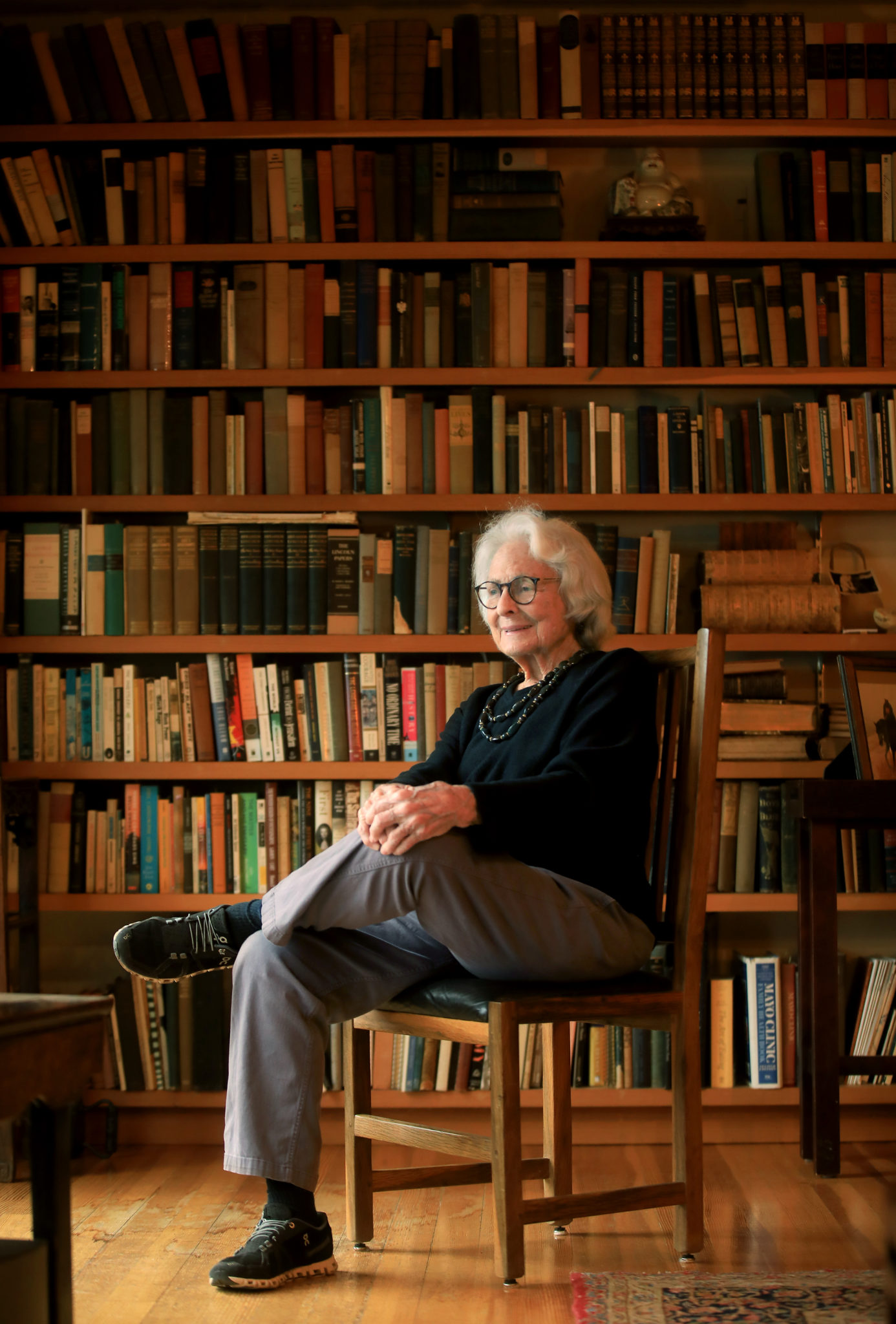
As the mountain’s large holdings were broken up into smaller parcels, long horseback transits became impossible, and these days, horses are a relatively rare sight on regional park trails. An era has passed, an issue of considerable poignancy for Cooke. She grew up during a period when people had strong community and working roots in the mountain. They were ranchers, grape growers, local businesspeople, artists.
And now?
“This street used to have bunches of kids on it, running around, exploring the woods,” Cooke recalled. “Now it’s all just people coming up from San Francisco to stay for weekends at short-term home rentals. Who can afford to live here now? Not working people.”
She doesn’t know how long she’ll stay on the mountain. “It’s been tough. It still is, really. But there’s something about this place. It just makes you want to stay.”
Tensions between established customs and new priorities, between longtime residents and newcomers, constitute a baseline narrative for the mountain, one that continues to play out. That’s obvious at Belden Barns, a combination grape ranch and farmstead near the junction of Pressley and Sonoma Mountain roads. This property has particular significance for me: It’s where I lived for 15 years, back when it was Steiner Vineyards. Long before that, it had been a resort called The Highlands with tennis courts and a dance hall that was turned into a speakeasy during Prohibition. In the 1940s, it produced sheep and prunes before my friend David Steiner planted it with cabernet sauvignon vines in the early ’70s.
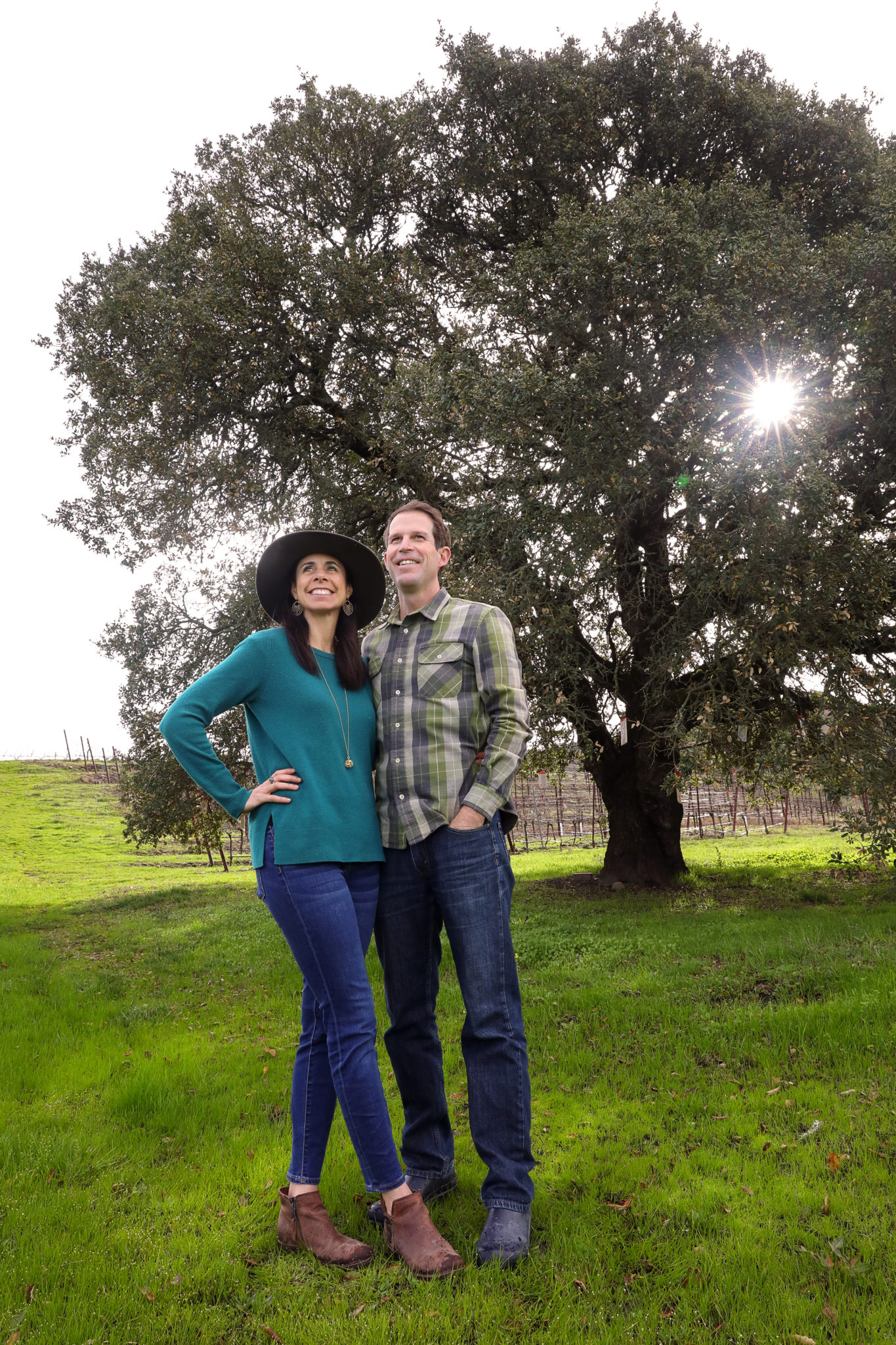
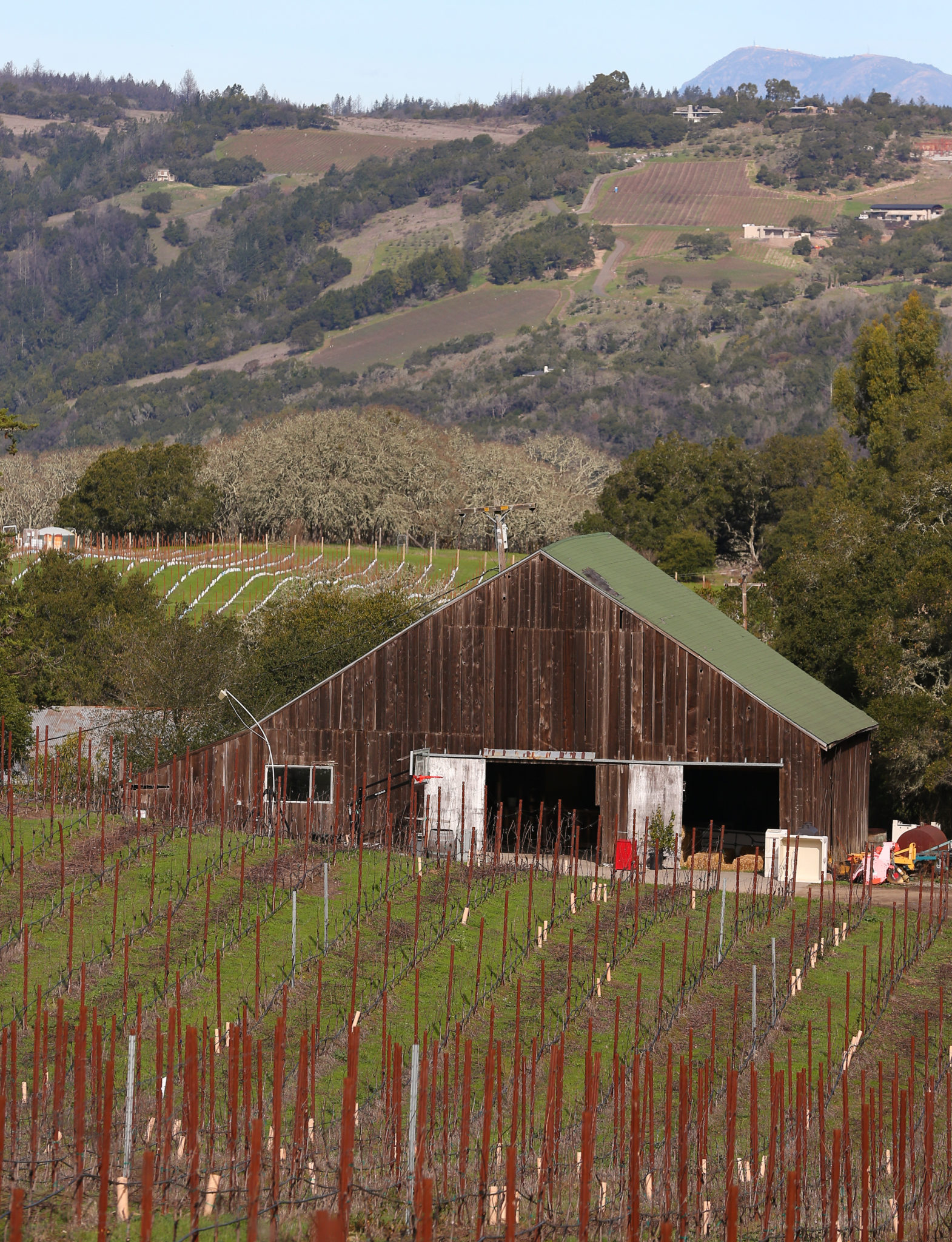
It’s now the property of San Francisco residents Nate and Lauren Belden, a couple with backgrounds in finance and marketing who bought the 55 acres in 2005 for $3 million.
Nate Belden had grown up with sets of grandparents who owned a Montana cattle ranch and a farm in western Nebraska. When he moved to San Francisco with his family he became interested in grape growing and winemaking, taking enology, viticulture, and organic farming classes at UC Davis and Santa Rosa Junior College.
He and Lauren shared an expansive vision for their property: a small farm producing a variety of comestibles from wine to truck crops and cheese, a campus for the teaching of sustainable farming techniques, and a destination for Wine Country tourists. In 2014, the couple filed plans with the county to build a 10,000-case winery, a creamery, farmworker housing, and a tasting room and hospitality complex; they also wanted a permit to hold special events at the property, including weddings and harvest parties.
County planning commissioners unanimously approved his project, but a group of neighbors, worried about increased traffic and disruption of the area’s bucolic atmosphere, balked and appealed to the Board of Supervisors. A long legal and political tussle followed, with hard feelings developing on both sides. Finally, an agreement was reached that allows the couple, parents of two young kids, to build a small winery and a creamery that will produce up to 10,000 pounds of cheese a year. The Beldens also will be allowed to conduct a limited number of special events and conduct wine tastings by appointment.
I dropped by the former Steiner Vineyards property to revisit old memories and appraise the Beldens’ operation. I was met by Nate in the ranch’s parking area. He’s a lanky, fit, cheerful man who seems wellsuited to his new agrarian life. As we shook hands, I looked around and was somewhat startled by what I saw. The vineyards were well-maintained but all the giant eucalyptus trees that had lined the long driveway to the main compound had been felled. “Some of them came down across the road, and we decided they were too dangerous to stay,” Belden said.
Other trees — some huge cypresses and several old pear and prune trees — also had been removed, as had a lovely European chestnut that had shaded my porch. For that matter, the porch was gone. As was my old cabin. And the same was true for Steiner’s house: Just a lone wall fragment remained. The lower pasture where I had grazed my sheep had been worked over and compacted by heavy equipment and vehicles.
Nearby, a dirt driveway had been carved out and a modular building put up on adjacent flats. Behind the main compound, a marshy meadow that had supported a variety of birds had been plowed and cultivated, growing specialty vegetables, orchard fruit and berries — the work of a young couple who lived and farmed on the property. Construction materials, farming equipment and industrial oddments were piled up here and there. I recalled the old ranch as a shaded, cool, and green place. Now everything looked jumbled and naked beneath a beating sun.
But Belden was proud of the changes, and as he talked, I could understand — if not fully appreciate – his perspective. He acknowledged the long dispute with some of his neighbors had left some bruised feelings. Now, however, “Relationships are generally cordial. Many neighbors took the time to come and visit the site and discuss our intentions. Those folks went away impressed. Other neighbors that publicly spoke out against the project at county hearings have since come up to us and apologized. In the end, you find that you’re just not going to be able to make everyone happy, which is hard for Lauren and me because we feel we have the best of intentions.”
Talking to Belden, I couldn’t help but feel this was a conversation that had been rehashed many times on the mountain over the last 150 years — perhaps including at that very site.
And Belden Barns remains a work in progress, not a realized dream. When the hospitality complex, farmworker housing, creamery, landscaping, and agricultural plots are fully developed, it’ll all likely look as bucolic and appealing — if different — as the ranch of my memory. I had no right to feel proprietary about the place; I had been a mere tenant, not an owner. Yet, it all somehow gnawed at my heart. For me, the mountain is a hallowed place. And, as David Best intimated, even its owners are mere caretakers, placeholders in the flow of geologic time.
But maybe that’s the greatest solace. Change may be inevitable, but the specific impacts of change are not necessarily immutable. The mountain has been logged. The trees grew back. Houses were built. Crumbling foundations are all that remain. It’s clear to me that we can make our marks on the mountain — but in the fullness of time, they will prove superficial. The mountain will endure.



